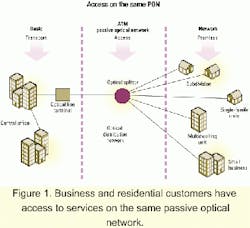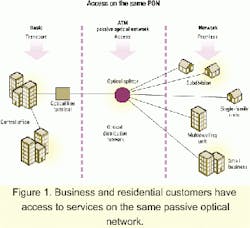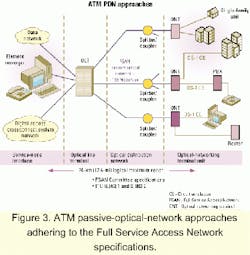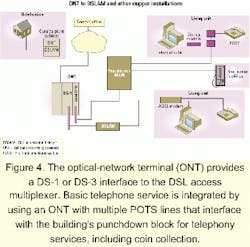Integrating business and residential PONs
Last-mile solutions based on passive optical networks will challenge traditional network architectures.
BART ALVAREZ, Paceon Corp.
Fiber-to-the-business (FTTB) and -home (FTTH) are closer than many people think. Passive optical networks (PONs) that support applications for both business and residential customers on the same architecture are now economically feasible. These networks transport voice, data, and broadcast services for business, single-family, and multifamily homes, and small-office/home-office applications (see Figure 1).This shared approach will encourage optical distribution network facility owners to invest in the build-out of the last mile. The investment in the last mile-costs the local facility owner will be expected to incur-is enormous. The main obstacle is whether the local facility owner is able to generate enough revenue to pay for the new fiber access network.
For residential customers, the major challenge of providing network access is build-out costs versus revenue. Even though there are many existing and future applications that residential customers may want, the service revenue derived is low compared to the overall investment. Estimated costs of last-mile construction are $32,000 to $45,000 per mile; the electronics are the smallest percentage of overall cost. Shared fiber networks will help pay for new fiber access.The business network challenge is technology; typically, the facility owner can generate enough revenue to pay for new access networks. But PON over fiber is not always the first technology choice. Competing technologies include SONET and hybrid fiber/coaxial (HFC) networks.
An architecture that employs PON can mix business and residential applications. Revenue is increased per line, and the last mile becomes affordable (see Figure 2).
The mixed PON will originate from optical-network termination (ONT) devices at the home and business premises to a shared point in the optical distribution network where singlemode fiber is connected to an optical splitter. The ONT is a customer-premises unit that launches services to the subscriber. It provides POTS, video, broadcast TV, and high-speed data to the home and business. For business customers, it delivers DS-1, DS-3, and native LAN services.
The multiple paths from the premises are combined into the singlemode fiber at the splitter, which connects to an edge switch or optical line terminal (OLT) in the central office. The OLT is typically located in a central office or remote terminal and switches the data to the appropriate transport, such as class 5 voice switches and ATM data backbone switches. The OLT takes the traffic and sends it to the destinations. This transport process adheres to the ITU 983.1 Full Service Access Networks (FSAN) protocol standard. Churning keys that encrypt the packets protect the information. The ability to cascade the splitter helps keep costs in line; network owners share optical splitters as well as mix FTTH and FTTB on the same PON.Such a network is deployed, based on passive optical components that allow distances of 12.4 miles deep into the loop. It requires no repeaters, or power along the route, and supports fiber-to-fiber terminations. This architecture allows homes and business to share a network of telephone, data, video, and broadcast TV services (see Figure 3). Gas-pump credit-card swipes, ATM cash machines, and lottery tickets can be moved from individual DS-0 connections to DS-1s. A 1.5-Mbit/sec DS-1 or T1 channel can deliver 24 DS-0 connections at 64 kbits/sec each.
The optical distribution network, which consists of optical fiber, splices, connectors, and splitters, is the most expensive part of the PON; in most cases, the facility network owner is responsible for the installation of new singlemode fiber. The fiber is trenched, or in some cases, aerial fiber is installed. Even though the cost of fiber has come down, labor and materials are an investment issue for total fiber networks.
Emerging PON markets are upgrading how DS-1 or DS-3 connections are delivered, making it economically feasible for local facility owners. Network providers can free up copper, segment DS-1 and DS-3 traffic to more reliable networks, and enjoy the monthly savings of operating a passive-no power required-optical network.
Markets are emerging, but barriers remain. The two major issues blocking successful deployment to residential customers in single-family and multidwelling units is the need to guarantee 24-hours-a-day/seven-days-a-week "lifeline" phone services and provide power to the customer-premises device.
Power is an issue that can be eliminated. Small solar power sources can trickle-charge backup batteries, or DC power from a cabinet can be used. However, lifeline support could be an obstacle. The facility owners responsible for lifeline service are in the process of researching protection of the last mile. Protection is feasible at a cost that will be incurred by the network owner.
The current PON market of greenfield build-outs and existing copper-field will roll out soon. In greenfield build-outs, high customer penetration and delivery of video services using additional wavelengths will provide the revenue to drive the construction. Cable and broadband providers are normally secondary in the construction process. The local-exchange carrier is planning and constructing basic telephony services in parallel with the construction. In fact, the local facility owner is the first to arrive and offer full services. The same holds true in the new and existing multidwelling-unit construction.
In single-family-unit greenfield construction, aerial or underground fiber is used and a splitter will serve each home cluster. The splitter can be located in any existing outside plant cabinet. A splice enclosure will house the splitter-no power is required. The fiber drop is installed and connected to a home ONT placed on the outside or inside of the home. The splitter cabinet serves a number of homes forming a home cluster.
New high-rise buildings also provide the opportunity to install high-speed fiber during the construction process. A fiber can be installed via the interduct and connected to the building's serving cabinet. Fiber is installed to each floor and living unit. Each living unit has access to broadband applications or basic telephony (POTS-only) services. The network provider can also suspend services remotely. New shining buildings with office and residential collocations offer another potential FTTH and FTTB market.
The capture of copper installations is another market opportunity. The architecture is similar to PON with distribution cabinets serving a number of homes. An example of a fiber to existing copper approach is integration of the ONT into an area serving cabinet. The serving cabinet is fiber-fed; the existing copper drops are connected to the ONT. The facility provider has power to the cabinet. This approach allows service providers to offer T1 and Integrated Services Digital Network connections to small businesses on the same PON.
The ONT can also feed a digital-subscriber-line access multiplexer (DSLAM), which in turn provides customers with asymmetric DSL (ADSL) access to the network. The ADSL speeds are faster due to a much shorter loop. ADSL line verification becomes simple. The service-level agreements (SLAs) can be completed in hours versus weeks.Established buildings also can be served by a DSLAM. The ONT provides a DS-1 or DS-3 interface to the DSLAM; the living unit uses an ADSL modem. Basic telephone service (POTS) is integrated by using an ONT with multiple POTS lines that interface with the building's punchdown block. POTS and analog lines are available for modem and basic telephony services. Additional standard applications such as coin service could be integrated using PON (see Figure 4). A coin service is a public, semi-public, or customer class of telephone service that uses a coin-collecting device as a part of the station equipment.
The formula for PON's success rests on the economic models that need to be considered when a provider is creating SLAs for customers. The network planner must look at all current methods of operations and the paths already implemented and installed. Installation and provisioning time become important in this process. A unique cost is associated with every item.
This type of planning for new services allows the local facility owner to plan and build new central offices. One advantage of PON is the option to put the optical splitter near the customer, which means a short fiber drop. But part of the initial cost is all of the components at the location.
In short, residential applications will accelerate FTTH with PON, providing an entry point for the local facility owner to move from POTS to high-speed data and broadcast TV revenue. If the broadband PON shares FTTB and FTTH applications, the network facility operators will have the incentive to invest in the last mile. This massive transport installation is possible because products for FTTB and FTTH are now available and the optical distribution network costs are favorable. The direction is clear-mixed networks are the key to successful PONs.
Bart Alvarez is director of business development at Paceon Corp. (Duluth, GA).




